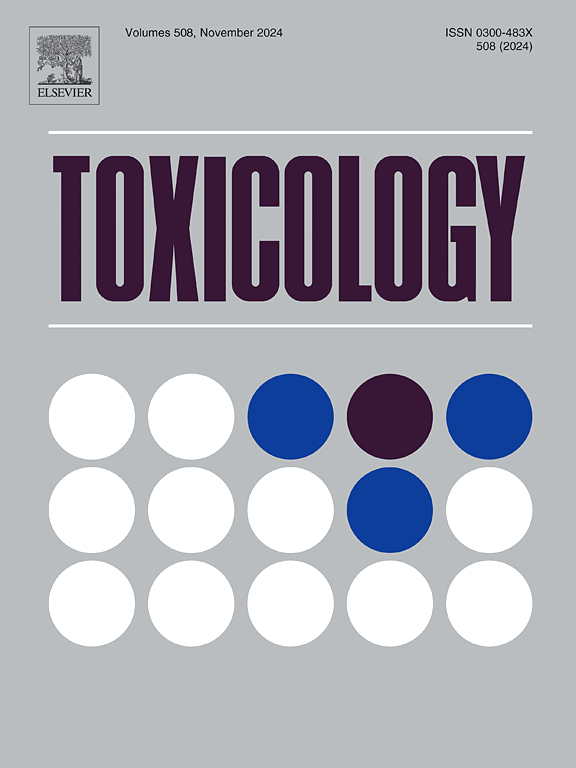Effects of CdTe quantum dot exposure on the calcium signaling pathway in rat dorsal root ganglion cells ND7/23
IF 4.6
3区 医学
Q1 PHARMACOLOGY & PHARMACY
引用次数: 0
Abstract
Previous study has shown that CdTe QDs exposure reduced ND7/23 cells activity and induced cell apoptosis in a time-dependent manner. The mitochondrial pathway was involved in CdTe QDs-induced ND7/23 cell apoptosis. The toxic effects at the subcellular level of ND7/23 cells after CdTe QDs exposure was still unclear. Whether the two classical mechanisms, endoplasmic reticulum stress and calcium ion imbalance, were involved in the subcellular structural and functional dysfunction of ND7/23 cells induced by CdTe QDs, and whether the Ca2 + -calpain2 pathway played a significant role in the CdTe QDs-induced ND7/23 cell apoptosis remained to be validated. Therefore, this research focused on the study of CdTe QDs exposure-induced endoplasmic reticulum stress, organelle damage, and calcium homeostasis imbalance in ND7/23 cells. The apoptosis signaling pathway mediated by calpain2 and endoplasmic reticulum stress were also investigated. The results showed that exposure to 10 μM CdTe QDs for 0–24 h resulted in an increase in intracellular and mitochondrial Ca2+ concentration, accompanied by swelling of the endoplasmic reticulum and mitochondria and loss of mitochondrial cristae. CdTe QDs exposure also led to an increase in the expression of endoplasmic reticulum stress-related Bip protein. CdTe QDs exposure also initiated the up-regulation of calpain2 and cleaved-caspase7 protein expression, as well as cleavage of caspase12 and PARP proteins in ND7/23 cells. Addition of the calcium chelator BAPTA-AM and the calpeptin 2 inhibitor calpeptin significantly inhibited CdTe QDs-induced apoptosis and reversed the expression of these proteins. This study confirmed that exposure to CdTe QDs triggered endoplasmic reticulum stress in ND7/23 cells, along with the activation of the calpain2-caspase12 signaling pathway, resulting in mitochondria-independent apoptosis.
CdTe量子点暴露对大鼠背根神经节细胞ND7/23钙信号通路的影响
先前的研究表明,CdTe量子点暴露降低ND7/23细胞活性,并以时间依赖性的方式诱导细胞凋亡。线粒体途径参与CdTe qds诱导ND7/23细胞凋亡。CdTe量子点暴露对ND7/23细胞亚细胞水平的毒性作用尚不清楚。内质网应激和钙离子失衡这两种经典机制是否参与了CdTe QDs诱导的ND7/23细胞亚细胞结构和功能障碍,Ca2 + -calpain2通路是否在CdTe QDs诱导的ND7/23细胞凋亡中发挥了重要作用还有待验证。因此,本研究重点研究CdTe量子点暴露对ND7/23细胞内质网应激、细胞器损伤和钙稳态失衡的影响。研究了calpain2和内质网应激介导的细胞凋亡信号通路。结果表明,暴露于10 μM CdTe量子点0 ~ 24 h后,细胞内和线粒体Ca2+浓度升高,内质网和线粒体肿胀,线粒体嵴丢失。CdTe QDs暴露也导致内质网应激相关的Bip蛋白表达增加。CdTe QDs暴露还启动了ND7/23细胞中calpain2和cleaved-caspase7蛋白表达的上调,以及caspase12和PARP蛋白的切割。钙螯合剂BAPTA-AM和calpeptin 2抑制剂calpeptin的加入可显著抑制CdTe qds诱导的细胞凋亡,并逆转这些蛋白的表达。本研究证实,暴露于CdTe QDs可触发ND7/23细胞内质网应激,同时激活calpain2-caspase12信号通路,导致线粒体非依赖性凋亡。
本文章由计算机程序翻译,如有差异,请以英文原文为准。
求助全文
约1分钟内获得全文
求助全文
来源期刊

Toxicology
医学-毒理学
CiteScore
7.80
自引率
4.40%
发文量
222
审稿时长
23 days
期刊介绍:
Toxicology is an international, peer-reviewed journal that publishes only the highest quality original scientific research and critical reviews describing hypothesis-based investigations into mechanisms of toxicity associated with exposures to xenobiotic chemicals, particularly as it relates to human health. In this respect "mechanisms" is defined on both the macro (e.g. physiological, biological, kinetic, species, sex, etc.) and molecular (genomic, transcriptomic, metabolic, etc.) scale. Emphasis is placed on findings that identify novel hazards and that can be extrapolated to exposures and mechanisms that are relevant to estimating human risk. Toxicology also publishes brief communications, personal commentaries and opinion articles, as well as concise expert reviews on contemporary topics. All research and review articles published in Toxicology are subject to rigorous peer review. Authors are asked to contact the Editor-in-Chief prior to submitting review articles or commentaries for consideration for publication in Toxicology.
 求助内容:
求助内容: 应助结果提醒方式:
应助结果提醒方式:


